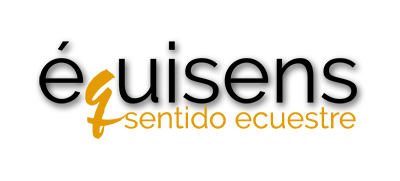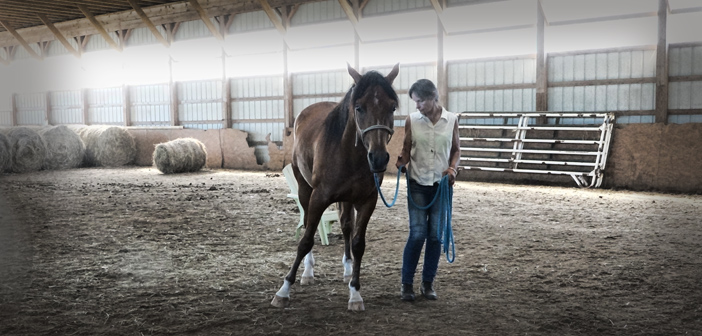Question by Beatriz Ferrer Salat (Olympic Dressage Rider). How can you help a horse that is heavy on the forehand by using the “feel and release” approach?
“FEEL & RELEASE” is the approach developed by California rancher, Bill Dorrance, of Salinas, CA. Leslie Desmond worked as his apprentice for five years and before he died in 1999, she co-authored and published his classic training manual, called “True Horsemanship Through Feel”
I recently asked my father for his main thoughts about horses. In particular, I wanted to hear his opinion about the way a horse makes a person feel. I also wondered whether he knew how, or why, a horse so easily accommodates the human will.
This is what he said:
“When you get on a horse, number one, they are warm. Your whole persona is enlarged because of your association with that huge beast and its powers and, what is most remarkable, is that it is willing to support you in the decision to take over the governance of the relationship at that moment,” he said. “They don’t have to agree, but they do.”
My father is no longer the assertive rider that he was. At 88, he is now a passenger, but, incredibly, his young mare carries him on safe rides through the woods.

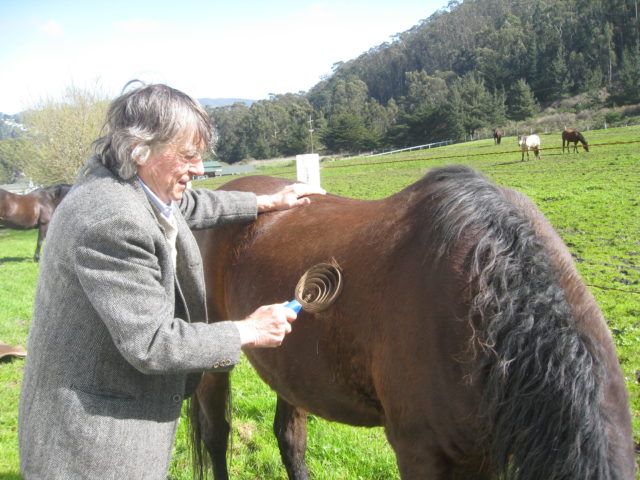
She understands and follows his instructions, and goes slowly in a light and eager way, wherever he directs her. She has interest in all assignments, and energy for them, too. When he needs extra time to do things, she patiently waits. She responds easily to his slightest gestures.
The mare’s striking capacity for the human connection allows her to reveal and share these precious moments at this vulnerable time in my father’s life. That a green horse (she is only six) with minimal training, can “read” a person’s intentions and honor them is remarkable. “Whatever I have been able to accomplish with horses is attributable to their capacity for allegiance, decision-making, and forgiveness,” he said.
I agree. And, I have noticed that it is these qualities that enable horses to successfully manage the often unreasonable requirements and situations people present to them.
These qualities were a critical link to their survival in the wild, just they were later, in civilizations.
Most horses were worked to death — often without thanks or acknowledgement — by the people who are credited with the successful defense of the nations that horses helped build in the first place!
Although they are not needed for these jobs as much now, people still expect a horse to cooperate fully for many other assignments, whether the horse is actually trained to understand what to do, how to do it, or why they are doing whatever it is. For this reason, the deeper aspects of a horse’s nature must be recognized, and well looked after.
Detailed descriptions of several exercises that can help a horse retain these assets are at the end of this article.
Respect for the basic nature of the horse is the key to the retention and maintenance of true lightness
From the moment training begins, a horse’s essential nature must be respected. When the horse is respected, natural lightness will remain intact during its life as a riding or driving horse, and when used for other labors.
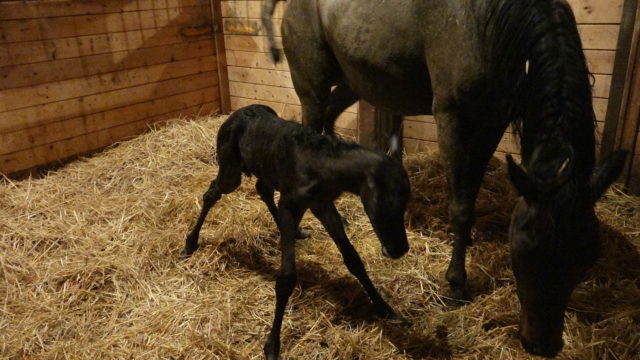
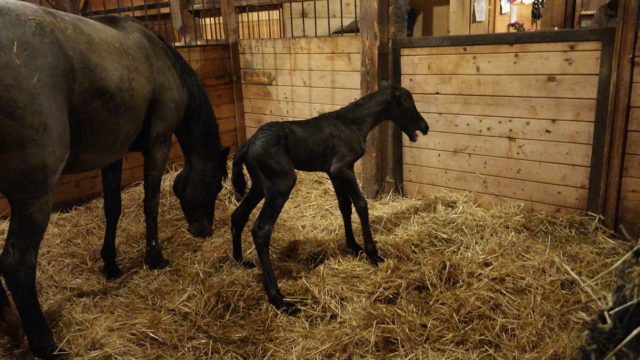
When a horse’s natural flexibility, light movements, and willingness to please are altered too much, its curiosity and natural lightness fade from existence. Often it completely disappears and, only rarely, will it to show up again.
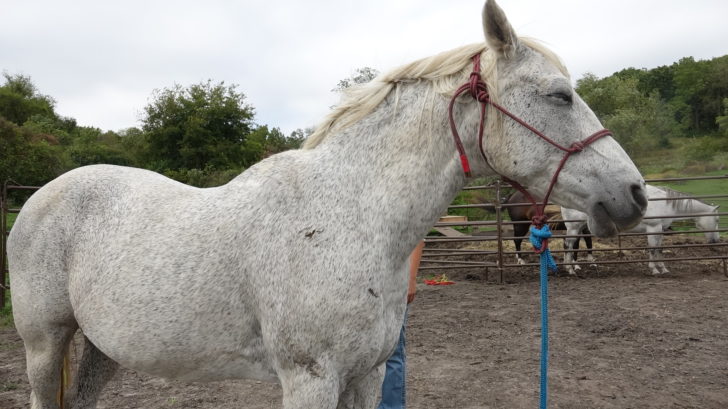
Fortunately, it is possible in most cases to restore lightness, and this begins with an awareness of the horse’s movements, and the particular way a breed moves the feet in each gait. When there is too much mental and physical damage, it is not possible.
To lighten up a forehand on a horse that has become resistant, bored, tuned out, heavy and dull….then the person handling or riding the horse must have a clear idea about what he/she expects the horse to do with its feet.
For a horse to remain light and reliable, it must be SURE that the person who directs its movements and shapes its posture knows what they want the feet to do. This calls for well-educated hands and legs to determine the sequence of a horse’s decisions about the direction and speed of hoof placement.
True lightness is not possible to maintain or to restore without this knowledge.
Riding and competition horses that have become desensitized around the face, neck and shoulders during handling and basic groundwork are usually referred to as “dull” horses – as if they were responsible for this condition.
They are not.
Continual crowding at the head and eyes, and contradicting instructions, when combined with other forms of human confusion and rudeness cause a horse to tune out. This is the result of training errors made by nice people who love horses!
This does not change the fact that they create horses that are pushy, heavy on the forehand.
Crowding the horse and handling the face and shoulders incorrectly at a young age makes an older horse difficult to back up and liven up and, sometimes, even difficult to ride. Horses like this are called “disrespectful”, and are frequently punished and corrected for doing the things that well-meaning people cause them to do!
These unwanted habits start very early in a horse’s life. They are encouraged by people who stand too close to the face and block the horse’s vision while they kiss and caress the nose and face. The tendency to lean and crowd and push into people with the left shoulder and neck is further encouraged when people feed sweet treats, apples and carrots by hand.
Frequent presentations of “human-affection-behavior” sets up an expectation in the horse that close and intimate, pet dog-like contact is desired and required. Most horses are corrected routinely for this learned behavior — sometimes very harshly.
This “too-close, too-often” human tendency creates stables full of horses that act like pet dogs, and also leads to stiffness and problems when going to the right under saddle.
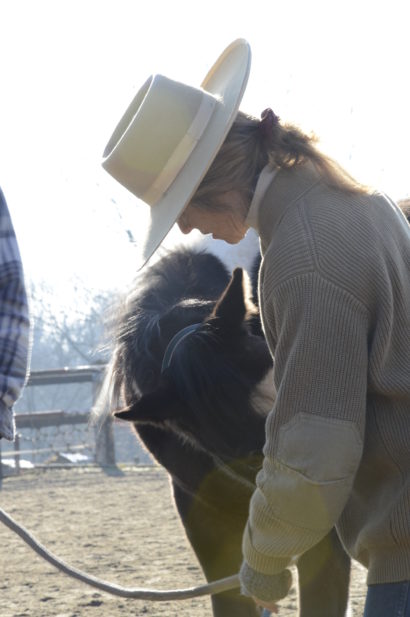
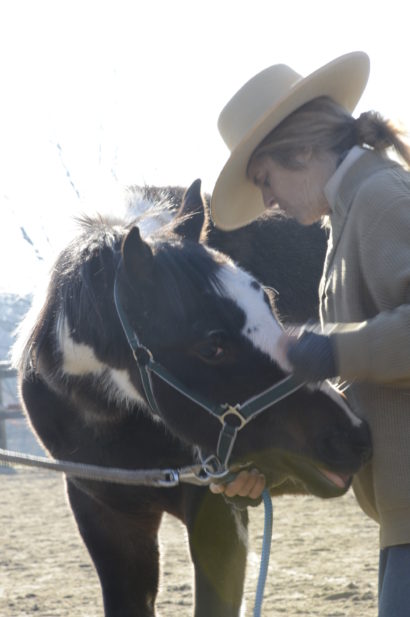
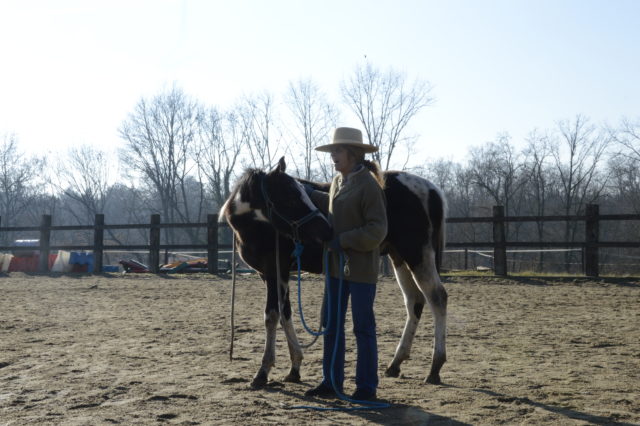
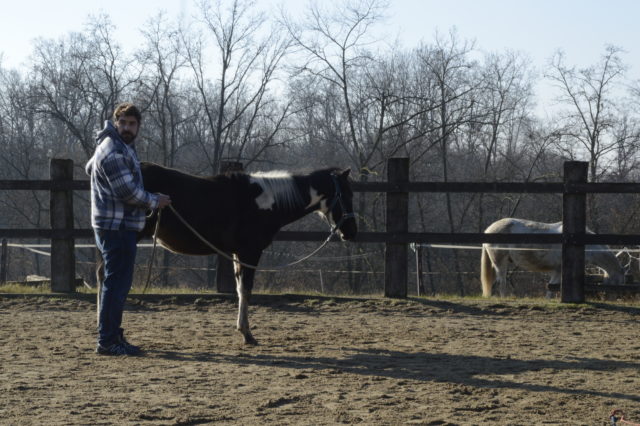
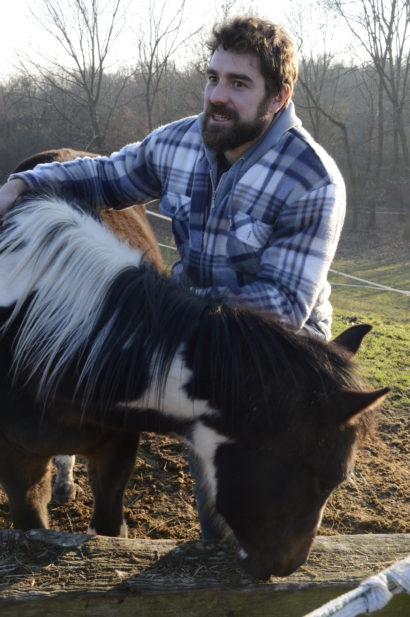
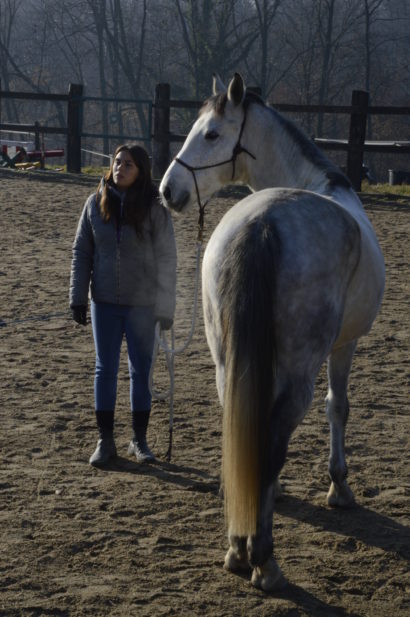
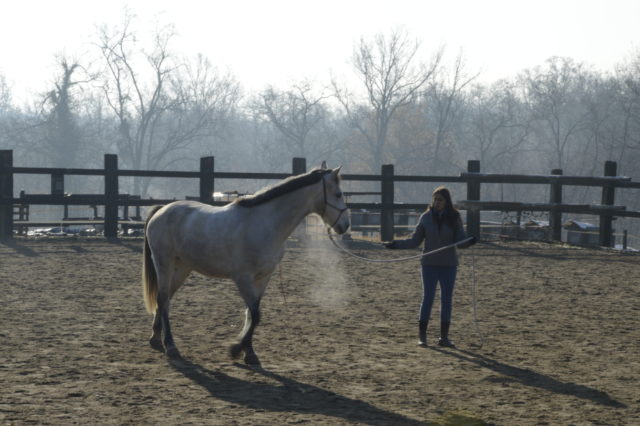
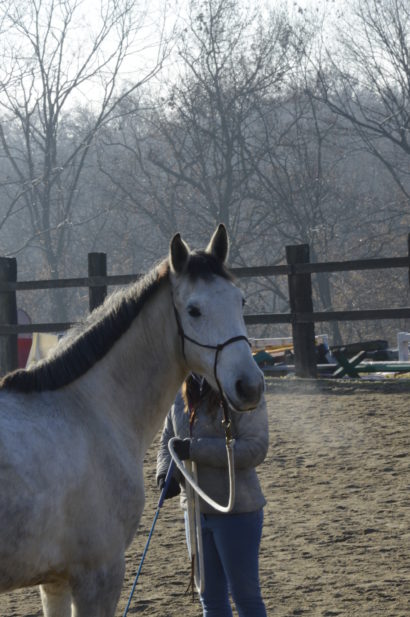
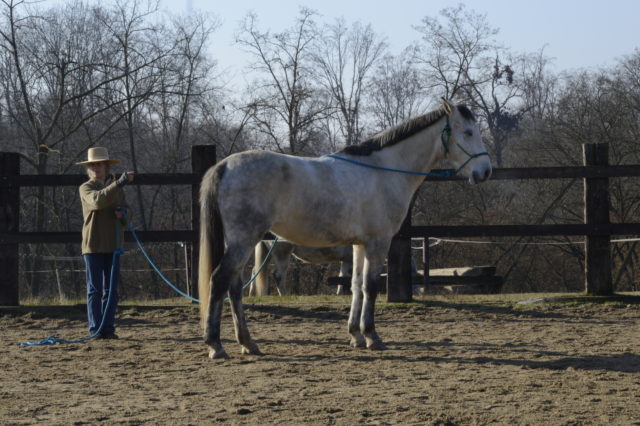
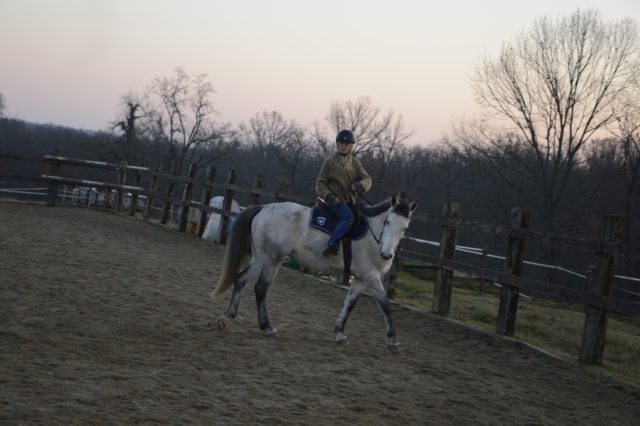
The ride reflects the actual facts. Without a balanced introduction to humans on the ground between birth and the day that mounted work begins, the ride will be as stiff, as crooked, and as difficult to manage as the horse itself on the ground. It is not easy to correct under saddle what has been overlooked, and or incorrectly taught during early training on the ground
When a person stands on the right side of a young horse that has been handled exclusively on the left side, many cannot understand how to maintain the connection unless the person remains visible in the left eye.
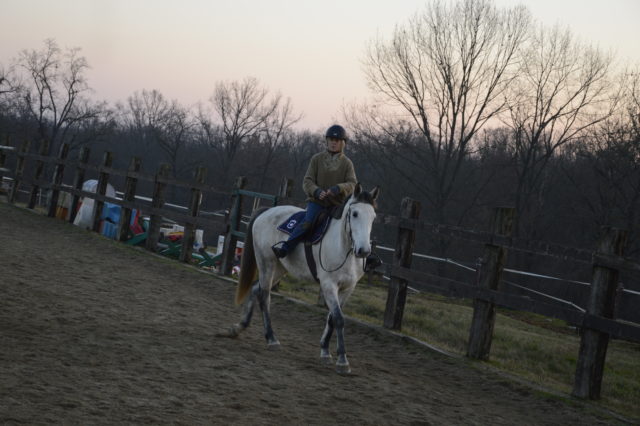
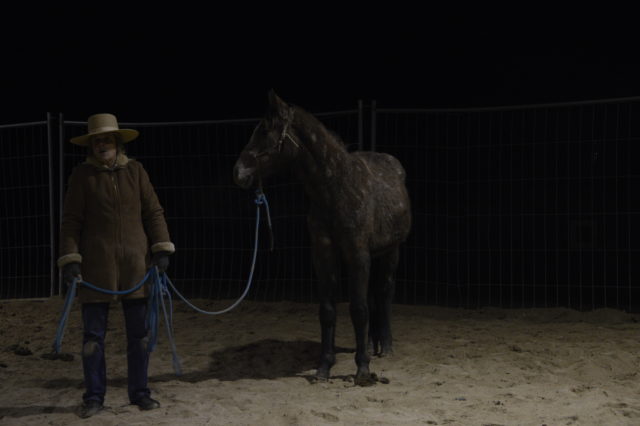
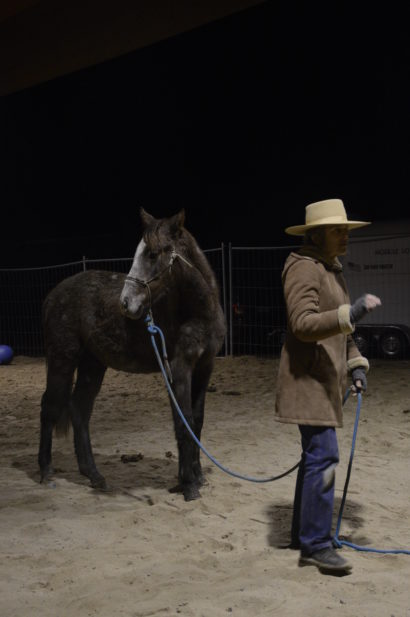
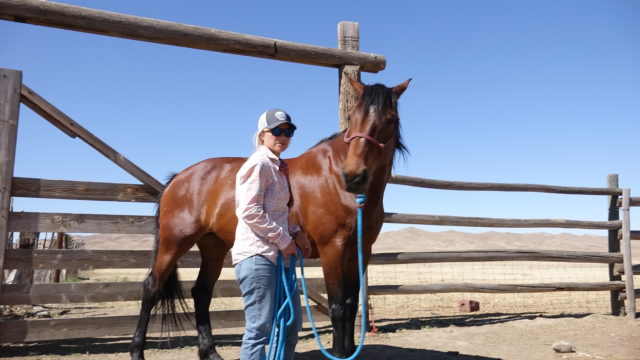
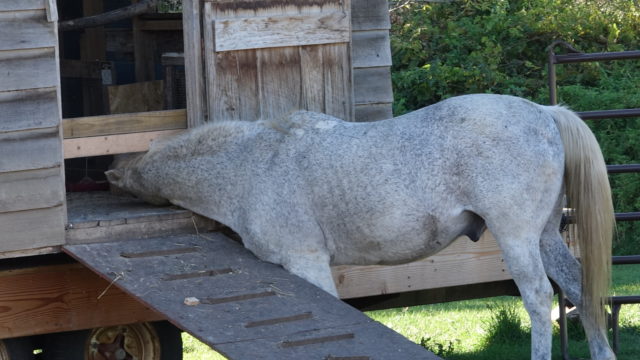
To remain calm and to be settled in new surroundings, a horse needs to be able to see what is going on around him. When human affection and need for a close social experience at the face is imposed on a horse, at any age, it fundamentally changes them. For example, horses that are taught to take treats from the hand also learn to endure the corrections for crowding the person who rewards it for getting too close.
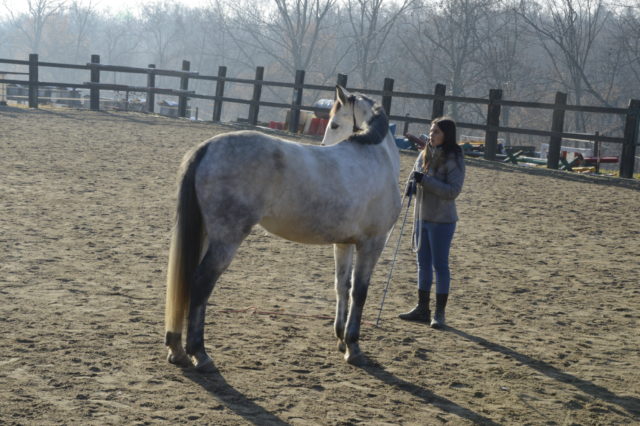
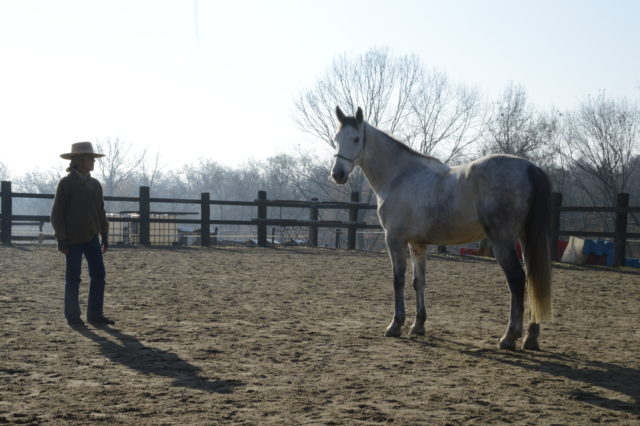
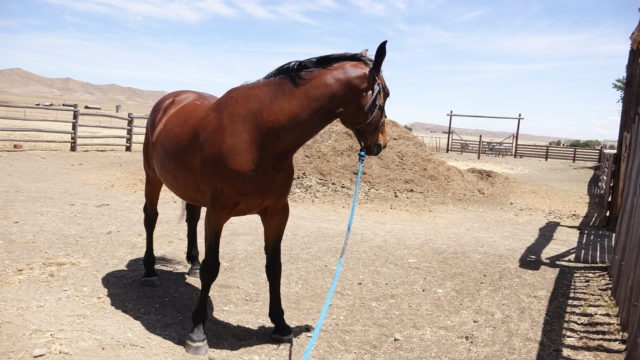
Illogical behavior disturbs a horse and, usually, creates an evident instability in the relationship which can be seen by the use of a whip or stick or other tool to keep a horse at a safe distance when it is being lead somewhere or managed on the ground.
This degree to which this happens varies in each situation, but, whenever a relationship that hinges on crowding a person for a handout and getting a rewards and nearly-simultaneous correction for “taking the bait”, it happens.
Young horses easily get upset and claustrophobic when they are crowded at the face and head and neck. The problem of disrespect and heaviness soon combine in a bad way when a horse receives corrections at the face and neck and shoulders when he is tied and, at other times, when held on a short rope. A punishment presented to a horse that is tied up, or held closely on a short rope, makes the problem worse: a horse becomes even more disrespectful, and, in the end, can learn to resent and fight a person for these very confusing behaviors. It is good news that this unwanted behavior usually changes immediately when a person backs out of the immediate area and lets a horse have enough room to see!
Example: “Come here, Stormy! Come here for a visit and a treat, Cupcake! Here is your apple!”
As hoped for, here comes the horse and eats a treat from a hand. That tasted GREAT! And, is there a second one that will taste good as well….yes? Often there is. So, having been rewarded for crowding a person the first time, the horse moves closer in hopes of another reward!
Is there any reason that a horse wouldn’t think that to repeat the experience is not the best plan? When a reward for crowding into a person’s space is consistent, horses believe it is expected.
But, when the person has no room to move out of the way, or has no more goodies for the horse?
“Bye-Bye horsey!” “Go away now, that was all!” “I said, ‘no more!’”
“Bad boy, you only get one! Now, get back!”
Does the horse understand this? He does not.
Treating horses like dogs turns them into 500-600 kilo rude dogs. Dangerous stuff!
To the point >>>Human crowding at the head neck and shoulders changes the way a horse operates around people.
The most common result is the creation of an extremely heavy, sometimes barely movable horse that is not that nice to be around on the ground, or to ride. Many get so heavy on the forehand that they cannot be motivated forward, and become even harder to stop after they are finally running! Such situations can quickly become unsafe.
This can lead to other unwanted and even dangerous behavior when the horse is suddenly excited or frightened. To restore lightness and accountability in a horse that has learned to be a confrontational and pushy pet, the focus of re-training must be to inform the horse about the importance that his former lightness plays in the renewed relationship.
NOTE! When the trainer’s focus is on the application of punishments or corrections for unwanted behavior (excessive heaviness on the forehand, for example), a lightness that is manageable is not likely to be the result. Punishments are more likely to produce a lightness that shows up as evasion, escape or other fear-based defensiveness. These are examples of lightness that are far from the goal. Lightness you can enjoy is the point! A rider wants to ride, not fight or fall off!
Remember, when a horse knows what you want, what you don’t want does not enter into its mind. When it knows what you want, it will be obvious in its decisions and its movements.
The following exercises are recommended for the complete restoration of lightness in a heavy horse whose spirit is still intact.
Humans must change first… A horse’s habit of crowding people begins to lessen when the people give up the habit of crowding a horse. There is a direct connection here. Wild horses and domestic foals do not naturally crowd people at birth. It is learned behavior, taught by the routines that people have around horses for their own convenience.
If lightening up the horse’s forehand is the clear goal, then a change in the way a person approaches the horse for social reasons is an absolutely essential aspect.
When haltering and bridling, or grooming the face, ears, head, and neck, as well as any non-essential involvement of a social nature, present yourself to the head from the mid-ribcage area. This requires the horse to learn how to bend his neck, to change its posture to reach you without moving its feet. This is the best way to teach him to partner with a person to accomplish a task, or to participate in the bonding and socializing interactions people frequently need.
It will take some time to teach the horse to wait quietly while you approach.
Do not encourage a horse to yield the hindquarters when you are re-training for a light forehand, as this only serves to confuse the horse by asking it to make the forehand heavy.
First, teach your horse to stand still
This is a basic exercise to rebuild a foundation in horses that have already learned that a PULL on the head means “Come Here!” “Move your feet!” How does he learn to think pull means go?
It happens when a horse has been allowed to eat grass while going for walks or being held over a lawn or other grassy area. There is nothing wrong with allowing this, but the way the horse is asked to STOP, GO and COME HERE in a rope and halter can teach him that a pull on the head means, MOVE YOUR FEET! COME NOW WTH ME!
What is wrong with that? Many people have no idea that from the horse’s point of view, if pull means “come here”, then it is quite difficult and confusing to know WHEN pull also means, stop, turn, half halt, collect in hand or under saddle.
Some horses think that pull means go when they are tied on a short rope. When they reach the unyielding end of that short rope, many horses will move their feet fast to get away when they feel the rope get tight. This is a very common problem that people unintentionally train a horse to do!
It works this way: If pull means go…a short rope tied to a fence or a tree is no different to that horse than the hand which pulled his head off grass. This is why it is so important to teach a horse to keep his feet still when you want.
The easiest way to be sure he understands this is to get his feet moving by other means. There are many other ways to move a horse’s feet than by pulling on his halter rope or his reins. If you approach a horse’s hindquarters, he will usually move his head and neck to watch you more closely, and some will move their feet to follow your movements as you walk toward the tail.
influencing the timing and placement of the feet controls the movements.
If a horse continues to yield the hindquarters on one or both sides when he is approached, then you can influence the front pivot leg he chooses to use for the purpose of re-balancing. If you ask him to pivot on the outside front leg, instead of the inside leg, the horse will start to understand that heaviness on the closest shoulder is not the response that you desire. Later, when that is clear, and if the handler/owner stays out of the face more often, the horse will learn to stand and wait. He will offer you whatever foot you want him to move; he will offer it to your outstretched hand, or allow you to lift and place, and then lift it again and re-replace it where you want on a short lead, or a long rope, or, without a rope.
Lateral exercises to increase flexibility, while standing.
After a horse can stand still until it is asked to move its feet, it is time to start asking the horse to move his head and neck from side to side. This is called lateral flexion.
When it comes to learning a new thing, horses are not very much different that we are. Even a little tip of the ear, or the head… just a few degrees to the left or right of center, is a sign of interest; his attention is focused on you. When offering new information to a horse, this seemingly too-small reaction is, actually, a big enough response to signal the person to stop asking. Eliciting the horse’s attention and noticing a small try is the first step to restore a horse’s confidence and generate its enthusiasm for cooperating with you. Refinement and perfecting your skills together comes later!
When the horse offers a response, and the request is still being made, the impatience for a perfect response prevents the horse from understanding that he is on the right track: “getting it!” Horses need time to think about the request made of them. There is an important feel of waiting, and of release as he is thinking about the right thing; this is one of the best ways to help a horse to adjust its way of carrying the head neck and shoulders at a standstill. This must be clear before he can fairly be asked to hold a specific, accurate posture while moving on the lunge line, or carrying someone.
Longitudinal Exercises when Standing
After a horse can stand still until it is asked to take a step, it is time to start asking the horse to raise the head and neck up and down. This is called longitudinal flexion.
With many horses, this can be learned at about the same time it is learning to shift the head and neck to the right and left — when asked. Whatever seems to work best, remember that short lessons are important because the horse that has just learned to be still is not ready for long lessons about other things before the standing still lesson is clear.
The exercises to practice after these basics are in place…are as follows;
Lead up freely; pass by on either side
The importance of this exercise cannot be over-stated. The sad fact is that many show horses are handled in a way that makes this simple task nearly impossible. The successful implementation of this exercise is the critical piece in the development of a free shoulder under saddle. The horse that can do this is one who is not stuck because it has the ability to shift its weight up and back during forward motion on his own without resistance, and also without assistance from a human. Evidence of this ability is seen in the horse that will be handled without ever taking the slack out of the rope.
Ironically, the handler of a horse like this is soon challenged to actually pull the rope tight! When a horse is trained through feel and release it knows the main job is to prevent the rope from getting tight. Tight ropes and reins direct a horse to immediately over-load the front leg on the side being pulled.
A well trained horse will feel for the intent of any movement, or change of tension or direction in the rope; it will move its feet in a way that reflects the handler’s intention. A horse trained this way has been shown, and learned, that a release on the lead rope or rein is intended to achieve lightness, accuracy and graceful movements under saddle. To a person who has learned the mechanics of “pressure-and-release”, this approach could seem counter-intuitive, even contradictory – in the beginning!
These four exercises are the first ones to understand and teach your horse, before any others
Bring the forehand around the hindquarters
You can accomplish this by asking the horse to either follow you in an arc, or yield from you on an arc (be directed away from you). This should be done on both sides, facing the horse, and can also be requested when facing the same way the horse is facing. This can be achieved without frustration or force. If the exercise is forced, the horse will learn about resistance. If it is taken slowly, one foot at a time, the horse can manage the task easily with enough time to figure out the assignment. With patience and clear instructions and enough time, any horse that is physically OK will do it for you, and its appreciation of your patience in the partnership will be apparent. This nice connection will carry you both forward well to enjoyable work under saddle with the same exercises. Slow and accurate steps are the only way to ensure that work at the faster speeds of trot and canter will also be graceful and accurate.
Ask the horse to take the hindquarters around the forehand
using the same gentle and patient approach explained above.Today, horses that have a typical natural horsemanship background will do this exercise too easily, and also incorrectly, by pivoting on the inside front leg and ending the exercise with the right hip dropped back behind the left hip. This is not the desired outcome because when repeated often it leads to a destabilization of the hips and pelvis, tightening of the psoas and adductor muscles and ligaments. If the horse you are working with has been handled and schooled this way, then offer a different feel so he can pivot on the outside front leg and leave the inside front leg available to do the stepping around. This will lead to a lighter shoulder and offer you both a good opportunity to add something new to an exercise that is mostly familiar to him.
In either case, whichever side you are on, and whichever hoof you are asking him to shift his weight to as his hindquarters step away from you, the last step should bring his hips into alignment.
(Note: Any exercise that a horse does “incorrectly and automatically,” by himself without a cue or request from the handler, is done without feel. When a movement lacks two-way feel, it is strictly mechanical. In addition to lacking grace and lightness, it is done in a tuned-out, accelerated speed, and has the potential to be dangerous. It is a popular notion to have horses “on auto-pilot” but those who think this is a good idea have not been hurt yet. A safer horse is TUNED IN to you, not tuned out.)
Back in a straight line
Before asking the horse to make a backwards arc in either direction, be 100% sure that his feet are clearing the ground when asked to back-up straight from both sides.
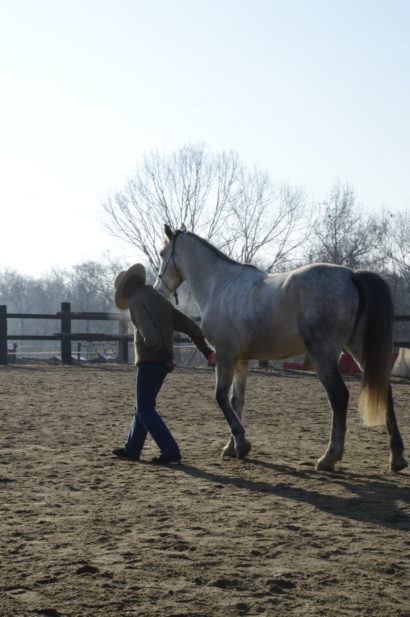
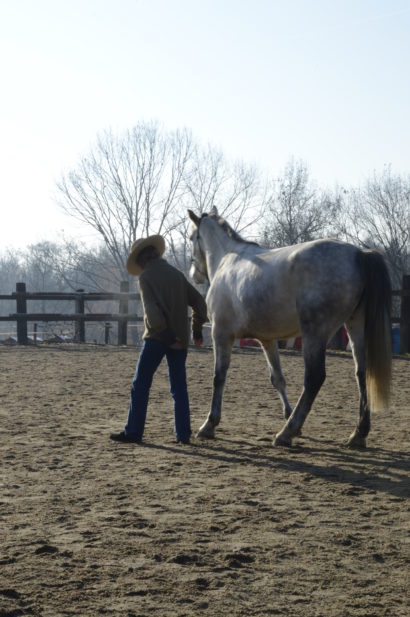
When there is a clearly established “feel of straightness” in the backup when requested from both sides of the horse, then it is time to ask for a quarter turn arc to left and right. Work at this until you can ask the horse to make a circle around you in either direction.
When backing a circle to the left, stand on the RIGHT SIDE of your horse. After he understands the feel of “back-up straight” presented at the halter knot, ask the horse to reach the leading shoulder away from you. This begins the ¼ turn arc. When backing an arc to the right, stand on the LEFT side of the horse. Again, first get your own feet in time with its front feet and back straight a few steps. By standing parallel to the horse and facing backwards, you help the horse understand how to extend the right shoulder and foot away from you. In the beginning, this exercise will feel counter-intuitive.
Remember that in order for a horse to back a circle, backing on a straight line, from either side of his body, without resistance is the best plan. If you have to push him or force it, he is not ready. You, also, are not prepared to offer him the best possible feel needed to learn to back an arc. Refinement of this particular exercise can lead to the smooth and willing execution of several useful maneuvers including a turn over the hocks, roll back, pirouette, flat spin and other moves that requires the solidly balanced and aligned hindquarters, 100% upon which an available forehand depends.
When you have been able to help the horse back in a ¼ and ½ circle, you can then offer a feel for him to back a large or small circle with both ends (the hindquarters and the forehand) reaching equally.
Speed transitions on a straight line, and in circles
When exercises 1-7 are successful and enjoyable, it is time to work on upward and downward transitions at the walk and trot on a lunge line in both directions. While many people start with this exercise, I like to have it come later; after the horse has learned how to maintain a round, soft posture that reflects the shape of the circle on a rope that between 5 and 8 meters long. When a horse is routinely asked to make a circle on at the end of a rope that is less than 6-7 meters, I have observed that other problems are likely to develop. When a short rope (under 6 meters) is used for lunging a large horse over 168 – 180 cm. an optimum relationship is difficult to experience.
These are the only steps I take to restore lightness. It will take time and must not be rushed. Nothing more than the refinement of these 8 exercises — and a change in the human way of relating socially to a horse — is needed to correct a horse that operates with an overloaded forehand.
The disappearance of a horse’s natural capacity for lightness is the unfortunate result of unintentional training that results in a heavy forehand and a pushy horse. People who are not aware of the connection between the things that they do to create this undesirable behavior in a horse, are actually creating the behaviors that make horses difficult to handle and appreciate on the ground, and irritating, or, even dangerous, to ride.
It is we who must make the changes.
Trainer’s notes
- Consistently reliable lightness in the forelegs is possible when the alignment and stabilization of the hindquarters moves into the #1 priority.
- No techniques, special equipment or exercises that are supposed to produce a lighter way of going can be effective or lead to lasting balance unless the hindquarters are solidly aligned.
- When the trainer is clear about the importance of well-aligned hips and hind legs and the adjustments that are necessary to produce this, there is very little chance that the horse will remain heavy on the forehand or crowd into people with his chest, legs, and shoulders.
- The biggest change in a dull, heavy horse occurs when people in that horse’s life improve the social and practical presentations to the horse to allow the horse to remain balanced.
- Horses can focus well on any job they are presented with, and if they are physically capable of doing what they are asked to do, most will stop at nothing to please you.
Replace correction and punishment for unwanted behaviors with education about desired behavior. Show the horse what you want and stay focused on the behavior you seek!
Text and Photos by Leslie Desmond . Copyright © 2017 Leslie Desmond and Diamond Lu Productions, LLC. All rights reserved.
